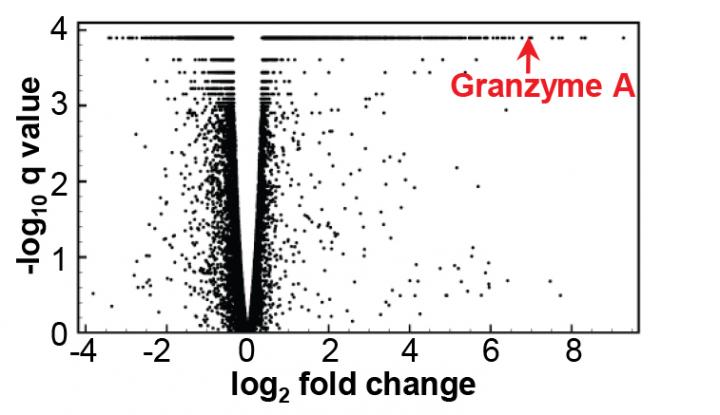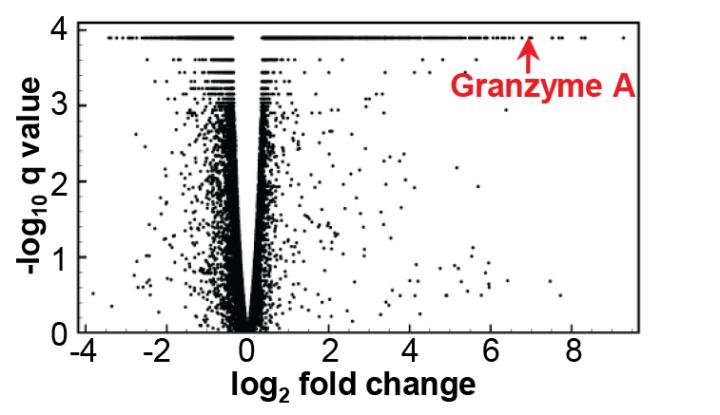
Credit: Wilson et al. (2017)
An immune system proteinase called granzyme A appears to promote arthritic inflammation in mice infected with chikungunya virus, scientists report in a new PLOS Pathogens study. The study also suggested that granzyme A could serve as a potential target for new drugs to treat chikungunya and related viral arthritides in people.
Chikungunya virus is transmitted by mosquitoes, with a recent epidemic causing millions of cases globally. While it is rarely fatal, chikungunya can cause severe, chronic polyarthritis (inflammation in multiple joints) and/or polyarthralgia (pain in multiple joints). Current standard anti-inflammatory drug treatment can relieve these symptoms, but they are often not particularly effective.
To aid research into potential new treatments, Jane Wilson and Natalie Prow of QIMR Berghofer Medical Research Institute, Australia, and colleagues exploited an adult wild-type mouse model of chikungunya virus infection and diseases previously developed by the group. In the new study, they use RNA-Seq technology to examine in detail the mouse inflammatory responses to infection. They found that genes activated in the mouse model closely mirrored genes known to be activated in infected humans, providing a level of validation of the model.
Particularly prominent in the RNA-Seq analysis was the up-regulation of a number of granzymes, a group of proteinases secreted by immune cells that were originally thought to be involved in killing (via apoptosis) virus infected cells or other target cells. However, an emerging consensus supported by the new PLOS Pathogens study, is that some granzymes (particularly granzyme A and K) have a role in promoting inflammation.
Exploring further, the scientists showed that mice missing the granzyme A gene, when infected with chikungunya virus, experienced dramatically less foot swelling and arthritis. Furthermore, treating mice with a granzyme A inhibitor also significantly reduced foot swelling and arthritis.
They also found elevated granzyme A levels in blood samples taken from non-human primates infected with chikungunya, as well as from human chikungunya patients. Overall the findings suggest that granzyme A could serve as a potential drug target for anti-inflammatory treatments for chikungunya — and perhaps also for other inflammatory diseases. Further research will be needed to explore this potential and determine how well the new findings can be extended from mice to humans.
###
In your coverage please use this URL to provide access to the freely available article in PLOS Pathogens: http://dx.doi.org/10.1371/journal.ppat.1006155
Citation: Wilson JAC, Prow NA, Schroder WA, Ellis JJ, Cumming HE, Gearing LJ, et al. (2017) RNA-Seq analysis of chikungunya virus infection and identification of granzyme A as a major promoter of arthritic inflammation. PLoS Pathog 13(2): e1006155. doi:10.1371/journal.ppat.1006155
Funding: The work was primarily funded by the National Health and Medical Research Council (NHMRC), Australia (grant APP613622) . JACW was awarded an Australian Postgraduate Award scholarship by the School of Medicine, University of Queensland. NAP was in part supported by an Advance Queensland Research Fellowship from the Queensland government. AS is a principal research fellow with the NHMRC. BSL3 equipment was funded by the Queensland Tropical Health Alliance. The NHP studies were funded by (i) "Programme d'Investissements d'Avenir" (PIA) under Grant ANR-11-INBS-0008 funding the Infectious Disease Models and Innovative Therapies (IDMIT, Fontenay-aux-Roses, France) infrastructure and (ii) the Integrated Chikungunya Research (ICRES) project of the European Union FP7 project grant agreement no. 261202. The funders had no role in study design, data collection and analysis, decision to publish, or preparation of the manuscript.
Competing Interests: The authors have declared that no competing interests exist.
Media Contact
PLOS Pathogens
[email protected]
############
Story Source: Materials provided by Scienmag





